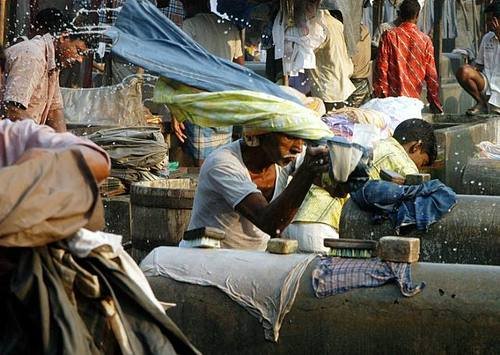Kimsooja
dal 20/4/2007 al 22/6/2007
Segnalato da
20/4/2007
Kimsooja
Kewenig Galerie, Koln
Mumbai: A Laundry Field

Mumbai: A Laundry Field
The Korean artist Kimsooja (born 1957 in Taegu, currently living in New York) began to incorporated fabrics into her work during the early 1980’s, which are used as a part of private everyday life in her home country. Made of bright colours and decorated with symbolic embroideries, people use them traditionally as bedcovers, but also to wrap the bundle to carry personal belongings. Detached from the utilitarian context, the colourful fabrics develop aesthetics of their own and become a universal symbol of life itself. While the character of the object was in the foreground at first, the human body itself became the object in space and time in the installation "Sewing into Walking", in which the artist moved her body as a symbolic 'needle', connecting between the bedcovers. The series of videos "A Needle Woman" (1999-2001), and "A Needle Woman" (2005), were filmed in cities around the world, where the artist's body is the central figure, visually present as a fixed point in the flow of the passing crowds.
Always on the move, Kimsooja develops her installations, performances, videos and photo-works by observing and juxtaposing different cultures and human conditions, as well as a structural investigation that has evolved in parallel throughout her practice.
After presenting the impressive installation of the Bottari Truck in her exhibition "Bottari Cologne 2005", it is now the latest work of the artist to be shown in the Kewenig Galerie.
The 3 channel video projection "Mumbai: A Laundry Field" was created in the Indian city of Mumbai, former Bombay, in recent months, as a continuity of her series of "A Laundry Woman".
In one of the three-channel projections, the camera takes the viewer through the alleyways of various slums of Mumbai. The living conditions that prevail in the different slums have their own structure, as well as their own specific religious communities. Though in some quarters Hindus, Muslims and Christians live in the same community, the parallelism of the different cultures remain. You find slums in which human dignity seems to be irrelevant and in which people, obviously ignored and abandoned by the rest of society, dwell – some living in cots - amidst the stench of trash and waste of bad plumbing systems. But even these areas appeal to the foreign visitor aesthetically, because of their colourful laundry hanging on walls and in narrow alleys. They are perceived as places that are – though inhuman conditions predominate – affected by zest for life.
The middle projection shows the washers of the quarter of Dhobighat at work. Water sprays vibrantly while the brightly coloured laundry is scrubbed, splashed, and dried. Even the washing place itself, which was created during colonial rule and demonstrates the hardship of the workers in Dhobighat seems to be filled with festive colours. The chore of the washer, the cleaning of other people's clothes, is relegated to the lowest class of people in the Indian caste system. It seems as if the washers - by tossing the laundry - are at pains to purify their own Karma. The sound of their heavy breathing appears to emphasise this impression.
The scene on the right screen shows a commuter train running through Mumbai, crammed-full with people. The travellers also sit on the train roofs and articulated axles in-between the wagons. Allegorically, the scene conveys the everyday struggle for life of these people. While the clothes of the rail travellers flutter in the wind and correspond visually with the drying laundry of the adjacent projections in a magnificent way, the viewer still poses the burdensome question concerning aesthetic value and fate of the individual in this society.
The images of the video work "Mumbai: A Laundry Field" have a direct and powerful impact. Its energy enchants and consternates at the same time. A conflict emerges from the consciousness that the viewer comes to question on the reality and it's hardships of tragedy and poverty, even violence, compared to the rich and colourful visual information and experience – obviously detached from reality – that embodies it's aesthetic value and quality.
For questions, further information, reproducible illustrations or interview appointments please contact Kewenig Galerie
Opening reception for the artist 20 April 2007, 7 – 9 pm
Opening hours of the gallery: Monday to Saturday from 10 am to 6 pm.
Kewenig Galerie
Appellhofplatz 21 50667 Cologne, Germany
Mon-Sat 10am-6pm



